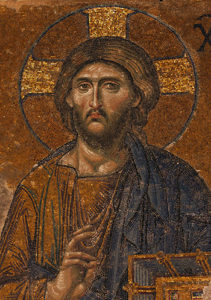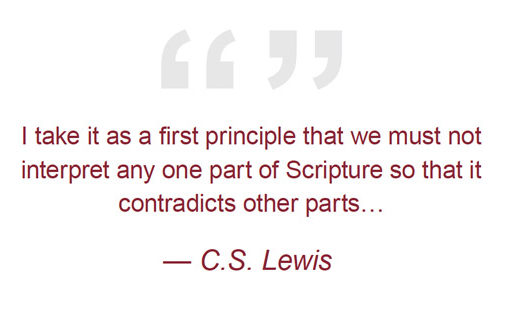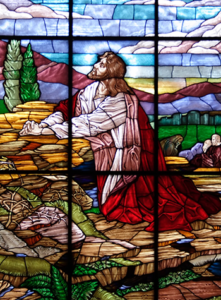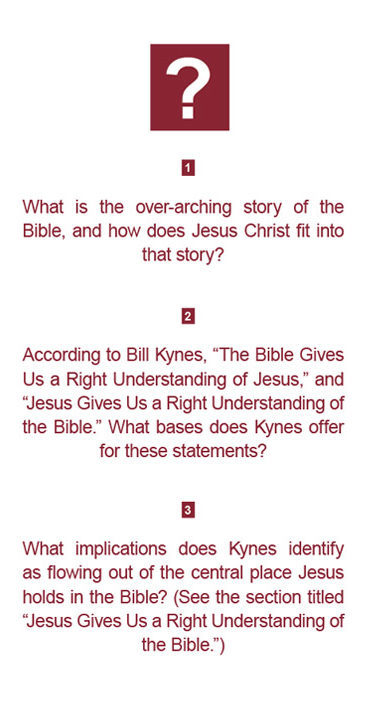Back to series


Recommended Reading:

Download or Listen to Audio
The Bible’s Center Is Jesus Christ
Click here to open a Print-Friendly PDF
(This is a four-part series on How to Read the Bible. Part 1, Part 2, Part 3, Part 4.)
So you want to read the Bible and read it well. You want to listen to what it has to say to you because you believe that ultimately God speaks through it. You believe, with the apostle Paul, that “All Scripture is God-breathed and is useful for teaching, rebuking, correcting and training in righteousness, so that the servant of God may be thoroughly equipped for every good work” (2 Tim. 3:16–17).1 But how can you read the Bible so that it will be useful for these things in your life?
 We began in part 1 by describing what the Bible is — a collection of sixty-six books, written by at least thirty authors over some fifteen hundred years. But this library of books is the product of one divine mind ensuring that, in all its diversity, the Bible has a unified message.
We began in part 1 by describing what the Bible is — a collection of sixty-six books, written by at least thirty authors over some fifteen hundred years. But this library of books is the product of one divine mind ensuring that, in all its diversity, the Bible has a unified message.
The Bible’s message is revealed in history, and we outlined the basic plotline of that story, from creation to new creation. In between, a drama unfolds of a relationship disrupted by human rebellion and then restored by the gracious work of God in Christ.
This overarching story in the four acts of creation, fall, redemption, and new creation provides the framework within which the various smaller stories of the Bible fit. And it is Jesus, the Son of God and Israel’s promised Messiah, who is at the center of it all.
His entry on the stage forms the great dividing line between the Old and the New Testaments, and in Him the whole narrative holds together. He is “the Alpha and the Omega, the First and the Last, the Beginning and the End” (Rev. 22:13).
Part 2 in this series built on this framework and considered how to interpret the Bible rightly. After all, many claim that the Bible can be made to say anything, and it has been. But we argued that we must follow our Master, Jesus Himself, in our reading of the Bible, and He points us to a number of interpretive principles that are to guide our reading.
The understanding of God and of humanity that Jesus reveals leads us to be interpretive realists; God is the author who speaks to us, and we can and must seek to understand Him. The Bible’s message is not something we make up for ourselves, but something we discover with God’s help. Because Jesus came to proclaim good news, that is, “gospel,” for it to be good news it must be intelligible to its hearers.
Thus we believe in the basic clarity of Scripture in its central message. But our theology also makes us critical realists in our interpretation. Because of our finitude as creatures and our corruption as sinners, God’s communication with us is not always clear and plain. We need the work of the Holy Spirit to be good readers of God’s Word.
Because God uses human authors to convey His truth, we can try to understand the Bible as we would any other written work.
We seek the authors’ original intent in writing what they did, taking into account the entire range of the historical, cultural, religious, linguistic, and literary factors that help us arrive at that intention.
But because of the divine Spirit at work with the human spirit in that writing, we must also understand the words of any one biblical author in the broader context of the whole of the canon of Scripture. The Bible, then, becomes its own best interpreter, and we trust in an essential consistency throughout the whole.
The Bible has a unified message, and the unifying center of that message is Jesus Christ. This principle of interpretation comes to us from Jesus Himself, for He taught His disciples to read the Hebrew Bible in this way: “If you believed Moses, you would believe me,” Jesus said, “for he wrote about me” (John 5:46).
"Your father Abraham rejoiced at the thought of seeing my day; he saw it and was glad” (John 8:56). “Beginning with Moses and all the Prophets, he explained to them what was said in all the Scriptures concerning himself” (Luke 24:27).
 For Paul the apostle, Jesus Christ is at the center of everything: “all things have been created by him and for him. He is before all things, and in him all things hold together… In [him] are hidden all the treasures of wisdom and knowledge” (Col. 1:16–17; 2:3).
For Paul the apostle, Jesus Christ is at the center of everything: “all things have been created by him and for him. He is before all things, and in him all things hold together… In [him] are hidden all the treasures of wisdom and knowledge” (Col. 1:16–17; 2:3).
Especially for our purposes, it is important to see that for Paul, this faith in the resurrected Jesus as Lord of heaven and earth did not form the basis for some new Roman mystery cult, with Jesus playing the role of the dying and rising god. No, this great event did not create a new religion; it fulfilled an old one. For Paul, this gospel of Jesus Christ was the same gospel that had been believed by Abraham (Gal. 3:8).
Paul claimed that what had been promised to Abraham was now being fulfilled in Christ (2 Cor. 1:20; Rom. 4:13; Gal. 3:19, 22). The gospel of Jesus Christ Paul preached was “according to the Scriptures” (1 Cor. 15:3–4); it was the message God “promised beforehand through his prophets in the Holy Scriptures” (Rom. 1:2).
The Bible Gives Us a Right Understanding of Jesus
This conviction of the continuity of the Christian message with previous biblical revelation means that Jesus can be rightly understood only in the context of the revelation of God in the Bible. Jesus was no Greco-Roman philosopher or Eastern mystic. Jesus fits into the story of Israel. He was a descendant of Abraham and of King David (see Matt. 1:1-17). He was a Palestinian Jew who was raised on the teachings of the Law and the Prophets of Scripture. He insisted that He did not come to abolish their words, but to fulfill them (Matt. 5:17).
There is a reason that Jesus was born as the son of Joseph and Mary and not fifteen hundred years earlier as the son of Abraham and Sarah. God had to prepare a people—the Jewish nation—for the coming of His Son through a long history of struggle. He had to reveal Himself as a holy God who came with moral demands.
He had to insist upon the necessity of blood sacrifice as the means of atonement. He had to allow the people of Israel to fall into sin to demonstrate the corruption of the human heart. He had to bare His heart as a God of faithful mercy. All this and more provided the context for a right understanding of the life, death, and resurrection of Jesus.
Jesus Gives Us a Right Understanding of the Bible
The Bible alone provides the context for rightly understanding Jesus, but we can equally affirm that only Jesus can give us a right understanding of the Bible. It all points to Him. Jesus described Himself as the true temple; He was the true vine and the good Shepherd; He was the antitype of the bronze serpent in the desert; He was the source of living water once found in the desert; and He was the light of life.
Jesus was the Danielic Son of man, the Davidic King, the Suffering Servant of Isaiah. “Beginning with Moses and all the Prophets, he explained to them what was said in all the Scriptures concerning himself” (Luke 24:27).
The author of the New Testament letter to the Hebrews begins with these words: “In the past God spoke to our ancestors through the prophets at many times and in various ways, but in these last days he has spoken to us by his Son” (Heb. 1:1–2).
And that author goes on to proclaim the far greater revelation that has come through Jesus than any that had come before. After revealing Himself in His own Son, what more could He say? All that God had spoken must now be understood afresh in the light of the revelation that has come through Jesus.
Several implications flow out of this central place that Jesus holds in the Bible, shedding light on how the Bible helps us to understand Jesus and how Jesus helps us to understand the Bible.
Jesus Fulfills the Role of Israel
 Matthew depicts Jesus as the fulfillment of the story of Israel. He begins his Gospel with a genealogy, showing that the story that began with Abraham, the father of the nation, and led to its greatest king, David, and then traveled through the nation’s greatest trial in its exile into Babylon finds its culmination in the birth of Jesus (1:17).
Matthew depicts Jesus as the fulfillment of the story of Israel. He begins his Gospel with a genealogy, showing that the story that began with Abraham, the father of the nation, and led to its greatest king, David, and then traveled through the nation’s greatest trial in its exile into Babylon finds its culmination in the birth of Jesus (1:17).
He is described by the magi from the east as “the king of the Jews” (2:2), and in response to the murderous threat of King Herod, Joseph and Mary flee with Jesus to Egypt, retracing the steps of the Israelites.
In fact, Matthew quotes the words of the prophet Hosea, originally used of Israel, to describe the return of Jesus to Judea — “Out of Egypt I called my son” (2:15; citing Hos. 11:1).
John the Baptist appears, preaching a baptism of repentance to Israel in preparation for the coming of the Lord, and then Jesus comes to him to be baptized. Over John’s objection, Jesus identifies with the sinful nation of Israel, and He Himself is baptized.
The heavenly voice then affirms His identity as the divine Son, and the Spirit in the form of dove comes upon Him.
Then Jesus, the Son of God, is led by the Spirit into the desert to be tempted. Unlike Israel in the desert after the Exodus from Egypt, Jesus is the Son who remains faithful to His Father in combating the temptations of the devil. Jesus returns to Galilee; a citation from the prophet Isaiah refers to Jesus as a “great light” that has dawned—a description once used of the nation (4:12–16; Isa. 9:1–2; cf. Isa. 42:6; 49:6).
And at the end of his Gospel, Matthew returns to this theme, as Jesus is crucified as the “King of the Jews” (27:11, 29, 37, 42). In His faithfulness to His Father, even to the point of death, Jesus lives the life that the nation as a whole had been called to all along but had failed to attain.
Jesus must be understood as the means of the fulfillment of that gracious promise to Abraham—that he would be the father of a great nation through which blessing would come to the whole world. And in the final scene of the Gospel, called “the Great Commission,” Jesus sends His followers to make disciples among people of all nations (28:18–20).
God’s plan to save Adam and his descendants was focused on Abraham and his descendants. But that plan ultimately narrowed to one of Abraham’s descendants—Jesus of Nazareth. In Jesus, God’s plan to redeem fallen humanity finds its center.
Jesus Creates a New Community of God’s People
A second implication of the centrality of Jesus in the Bible’s story is that through Him God creates a new community of His people that has continuity with the story of Israel. If Jesus is the true King of Israel, then all those who pledge their allegiance to Him become a part of His kingdom.
Jesus’s first followers form the nucleus of this new community; through the gospel story, we see that through their union with Him, these disciples share in His relationship with God as Father. These are the people He has come to save, and through His death and resurrection, those who are united to Him in faith become His new family, His church, His “body” of which He is the head.
 This means that through Jesus Christ, Christians — Jew and Gentile alike — become coheirs of the promises to Abraham. The New Testament Christians find their identity in Christ, and through Him, the blessings once given to Israel as God’s chosen people become theirs as well. They become God’s sons and daughters and are called “a chosen people, a royal priesthood, a holy nation, God’s special possession” (1 Pet. 2:9), expressions once used of Israel.
This means that through Jesus Christ, Christians — Jew and Gentile alike — become coheirs of the promises to Abraham. The New Testament Christians find their identity in Christ, and through Him, the blessings once given to Israel as God’s chosen people become theirs as well. They become God’s sons and daughters and are called “a chosen people, a royal priesthood, a holy nation, God’s special possession” (1 Pet. 2:9), expressions once used of Israel.
As a result, Christians can now read the Hebrew Bible as the “Old Testament” — that is, as the prelude to the new thing that has now come to pass in Jesus. The Hebrew Bible becomes Christian Scripture as followers of Jesus are now grafted into the Old Testament story of Israel. In this way, we can read the Bible as our story and not just the story of some ancient people unrelated to us.
Jesus Fulfills the Old Testament Law of Israel
 But when we read the story of Israel in the Old Testament as our story, we must still read it in the light of its fulfillment in Jesus Christ. Very significantly, we must recognize the change that has taken place in the way we understand the laws that the Lord God once gave to the nation of Israel.
But when we read the story of Israel in the Old Testament as our story, we must still read it in the light of its fulfillment in Jesus Christ. Very significantly, we must recognize the change that has taken place in the way we understand the laws that the Lord God once gave to the nation of Israel.
Consider, for example, the list of laws found in one Old Testament passage, Leviticus 19. Verse 11 is pretty straightforward, “Do not steal. Do not lie.
Do not deceive one another.” It is very easy to apply that to us. But what about the command just a few verses below, “Do not wear clothing woven of two kinds of material” (v. 19)? Anybody wearing a cotton blend? Or how about verse 27, “Do not cut the hair at the sides of your head or clip off the edges of your beard”? Hmmm.
Why should we obey the one command and not these others? And why don’t we sacrifice animals in a temple in Jerusalem or require converts to be circumcised or insist on refraining from all work on Saturday?
In the New Testament, Paul clearly affirms that “All Scripture is God-breathed and is useful for teaching, rebuking, correcting and training in righteousness, so that the servant of God may be thoroughly equipped for every good work” (2 Tim. 3:16). But how are the laws of Israel useful for us in training us for godliness?
It is important to understand that in establishing Israel as His covenant people, the Lord was setting them apart as a means of revealing to them, and to the surrounding nations, something of His own character as a holy and gracious God. They were to be “a kingdom of priests and a holy nation” (Exod. 19:6).
Israel had a priestly role among the nations of the world, mediating the presence of God, and expressing to the world what Yahweh, the Lord, was like. And in this process, they were to return to Him the praise and worship He deserves. As this “holy nation,” God’s character was to be fleshed out in the particular socioeconomic setting of this one people.
Moses speaks of this when he says to the Israelites, “Observe [these commands] carefully, for this will show your wisdom and understanding to the nations, who will hear about all these decrees and say, ‘Surely this great nation is a wise and understanding people.’… And what other nation is so great as to have such righteous decrees and laws as this body of laws I am setting before you today?” (Deut. 4:6, 8). In this way, Israel was to be “a light to the Gentiles” (Isa. 49:6).
Israel’s very existence and character as a society was to be a witness to God. Israel was to be a model or paradigm of God’s holiness expressed in the social life of a redeemed community. The whole social structure of the people in all its various dimensions was to be a picture of the holiness of God. In this nation, God’s holiness was to be “fleshed out.” There is something “incarnational” about it—and, in that sense, it points us to Christ.
J ust as the redemption of Israel from the bondage in Egypt in the Exodus becomes a picture, or type, of our redemption through the work of Christ, so the law of Israel, as it is embodied in this particular nation, becomes a picture of the principles that ought to be at work in our lives and in our law today.
ust as the redemption of Israel from the bondage in Egypt in the Exodus becomes a picture, or type, of our redemption through the work of Christ, so the law of Israel, as it is embodied in this particular nation, becomes a picture of the principles that ought to be at work in our lives and in our law today.
The ceremonial laws, especially related to worship, now find their fulfillment in the work of Christ, who became the supreme and perfect sacrifice, superseding all others, and bringing that aspect of worship to an end.
In fact, all the regulations governing the temple of God are no longer needed, but Jesus is now the true temple—that place where God reveals His presence in the world. (And, in consequence, the apostle Paul declares that the church as the people of God where Christ dwells by His Spirit is now the earthly temple of God [Eph. 2:21–23].)
The laws related to the civil life of Israel, and those laws that set Israel apart from other nations, are now no longer applicable, because the people of God in the New Testament era is not a nation-state, but a new family composed of people from all nations.
There is no longer a need for outward manifestations of this “separated status” of Israel through the kind of clothes they wear, the food they eat, or how they cut their hair. These laws point us to the qualities of the heart, the moral virtues, that are now to be the distinguishing marks of God’s people, chief of which is love (John 13:35; Gal. 5:6). We are, as Paul says, to put on Christ (Col. 3:10).
And even the laws that appear to be more concerned with moral issues have to be understood in the light of the fuller revelation of God’s moral character as now revealed in the teaching of His Son. Our moral standard is no longer the law of Moses but all that Jesus has commanded us (Matt. 28:20; 1 Cor. 9:20-21).
In His Sermon on the Mount (Matt. 5–7), He affirmed the sacredness of human life, the sacredness of marriage, the necessity of truth, and the supremacy of love such that our righteousness is to exceed that of the Pharisees’. In fact, our standard is nothing less than the moral character of God Himself (Matt. 5:48).
The Old Testament laws have much to teach us about the holy character of God. But because Jesus has come to show us what those laws point us to, we must now understand them in the light of who Jesus is, what He has taught, and what He has accomplished. For “in these last days, [God] has spoken to us by his Son” (Heb. 1:2). When reading the Bible, we must understand it all in the light of its focus, its center, in Jesus Christ.
Jesus Christ — Israel’s Promised Messiah
Jesus is the Christ, Israel’s promised Messiah. This reflects the fact that the Bible is one long narrative, and all its various parts participate in this one great story.3 Furthermore, it implies that the Bible must be interpreted with an eye to progressive revelation. What has been revealed in the past is developed by what comes after.
The Bible is structured as promise and fulfillment,4 as Old and New Testaments, and it is crucial for our understanding of the Bible that we are aware of where we are in that structure. As someone put it: in interpreting the Bible, you must know what time it is.5 And always one must read the Bible with an eye toward its central and unifying character, Jesus Christ.
Notes:
1 Scripture quotations are from New International Version (2011).
2 Cf. Christopher J.H. Wright, An Eye for an Eye: The Place of Old Testament Ethics Today (Downers Grove, IL: InterVarsity Press, 1983), 43.
3 Cf. Irenaeus, Against Heresies 1.8.1; 1.9.4.
4 Cf. Jesus’s remark that ”the Prophets and the Law prophesied until John…” (Matt. 11:13).
5 Cf. Augustine: ”Distinguish the time and you harmonize the Scriptures,” cited in Bernard Ramm, Protestant Biblical Interpretation, 3rd rev. ed. (Grand Rapids: Baker, 1970), 37.

William L. Kynes
Pastor, Senior Fellow for Pastoral Theology, CSLI Pastor William L. "Bill" Kynes is the Senior Fellow for Pastoral Theology at the C.S. Lewis Institute, and retired Senior Pastor of Cornerstone, an Evangelical Free Church, in Annandale, VA, where he served from 1986 - 2022. He was an undergraduate at the University of Florida with a major in philosophy. There he also played quarterback and was later inducted into the university’s Athletic Hall of Fame. He attended Oxford University as a Rhodes Scholar, receiving an MA in theology. He received an MDiv from Trinity Evangelical Divinity School, before returning to England for a PhD in New Testament from Cambridge University. From 1997-1999, he served as an adjunct professor in New Testament for the Trinity Evangelical Divinity School Washington, DC, Extension Program.
Recommended Reading:
Michael Williams, How to Read the Bible through the Jesus Lens: A Guide to Christ-Focused Reading of Scripture (Zondervan Academic, 2012)
Many Christians today experience Bible teaching in isolated, unconnected pieces, receiving little or no guidance into how these pieces form a coherent picture in Christ. How to Read the Bible through the Jesus Lens presents Christ as the central focus of each biblical book and the primary way the Bible relates to contemporary circumstances. Each book of the Bible has an identifiable theme ultimately fulfilled in the person and work of Christ. Williams provides the following for his readers: • succinct statement of the theme of every biblical book • An explanation of how that theme finds its focus in Christ • A brief discussion of how the New Testament treats that theme as fulfilled in Christ • Suggestions for contemporary implications • Scripture memory electronic flashcards • A convenient summary chart. An excellent tool for Bible teachers, ministry leaders, and students, How to Read the Bible through the Jesus Lens facilitates other Christian disciplines such as Bible reading, Scripture memory and evangelism. By demonstrating how each theme relates to living the Christian life, this book promises to be an invaluable guide for reading and understanding the Bible.
 COPYRIGHT: This publication is published by C.S. Lewis Institute; 8001 Braddock Road, Suite 301; Springfield, VA 22151. Portions of the publication may be reproduced for noncommercial, local church or ministry use without prior permission. Electronic copies of the PDF files may be duplicated and transmitted via e-mail for personal and church use. Articles may not be modified without prior written permission of the Institute. For questions, contact the Institute: 703.914.5602 or email us.
COPYRIGHT: This publication is published by C.S. Lewis Institute; 8001 Braddock Road, Suite 301; Springfield, VA 22151. Portions of the publication may be reproduced for noncommercial, local church or ministry use without prior permission. Electronic copies of the PDF files may be duplicated and transmitted via e-mail for personal and church use. Articles may not be modified without prior written permission of the Institute. For questions, contact the Institute: 703.914.5602 or email us.
-
Recent Podcasts
The Faith of Jonathan Edwards
by Aimee Riegert, Arthur W. Lindsley on November 1, 2024Jonathan Edwards has been described as the greatest...Read More
-
A Scientist’s Journey to God – Krister Renard’s story
by Krister Renard, Jana Harmon on October 25, 2024
-
The Faith of Francis Schaeffer
by Arthur W. Lindsley, Aimee Riegert on October 18, 2024
-
Recent Publications
Will You Be Ready?
by Thomas A. Tarrants on October 23, 2024Tom Tarrants gives insights on how we can...Read More
-
Should Christians Be Involved with Politics?
by Kerry A. Knott on October 1, 2024
-
Isn ’t Atheism Based on Scientific Fact Whereas Christianity is Based on “Faith”?
by Cameron McAllister on September 1, 2024
0
All Booked
0.00
All Booked
0.00
All Booked
23169
ADVENT CALENDAR: The Amazing Prophecies Fulfilled by the Birth of Jesus Christ
https://www.cslewisinstitute.org/?event=advent-calendar-the-amazing-prophecies-fulfilled-by-the-birth-of-jesus-christ&event_date=2024-11-28®=1
https://www.paypal.com/cgi-bin/webscr
2024-11-28

Next coming event
Days
Hours
Minutes
Seconds
ADVENT CALENDAR: The Amazing Prophecies Fulfilled by the Birth of Jesus Christ
On November 28, 2024 at 6:00 amCategories
Speakers

William L. Kynes
Pastor, Senior Fellow for Pastoral Theology, CSLI
Team Members

William L. Kynes
Pastor, Senior Fellow for Pastoral Theology, CSLIPastor William L. "Bill" Kynes is the Senior Fellow for Pastoral Theology at the C.S. Lewis Institute, and retired Senior Pastor of Cornerstone, an Evangelical Free Church, in Annandale, VA, where he served from 1986 - 2022. He was an undergraduate at the University of Florida with a major in philosophy. There he also played quarterback and was later inducted into the university’s Athletic Hall of Fame. He attended Oxford University as a Rhodes Scholar, receiving an MA in theology. He received an MDiv from Trinity Evangelical Divinity School, before returning to England for a PhD in New Testament from Cambridge University. From 1997-1999, he served as an adjunct professor in New Testament for the Trinity Evangelical Divinity School Washington, DC, Extension Program.





